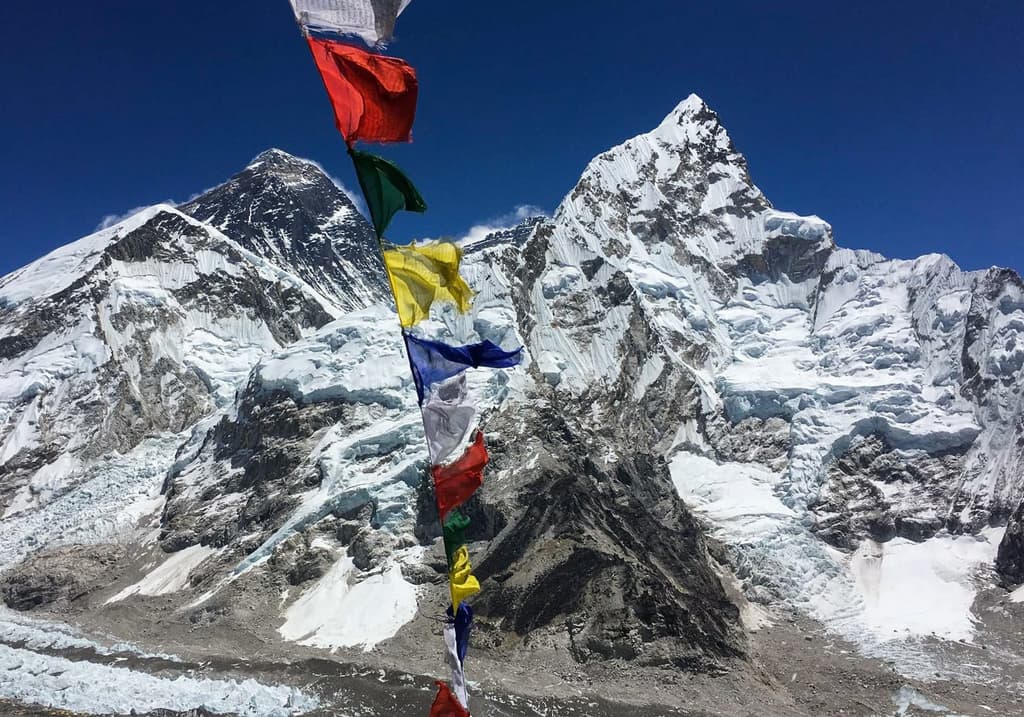Embarking on a trek to the Everest region is a transformative experience that combines raw natural beauty, cultural richness, and the ultimate thrill of adventure. At Luxury Holidays Nepal Pvt. Ltd., we understand that timing is essential in curating a trek that is both enjoyable and safe. The best season for trekking in the Everest region is crucial to consider for anyone planning this epic journey. Typically, the most opportune times are during the spring (March to May) and autumn (September to November) months, when the weather conditions favor clear views, manageable temperatures, and relatively stable trekking routes. Whether you're setting sights on the base of the world's tallest peak or exploring the surrounding valleys, choosing the right season enhances the trek's beauty and the overall experience. In this guide, we'll navigate through the nuances of the Everest Base Camp trek's best season, the optimal season for the Everest trek, and provide insights into the Everest Base Camp trekking conditions to help you plan your Himalayan adventure with confidence.
We stand as the epitome of excellence for those who seek an extraordinary journey in the Everest region, precisely timed with the absolute finest trekking seasons. Our seasoned expertise and client-centered approach ensure that your journey coincides with the optimal season for the Everest trek, offering a harmonious balance of awe-inspiring views, excellent weather, and cultural vibrancy. We are intimately familiar with the Everest region trekking months and meticulously tailor our itineraries to take advantage of the best weather for the Everest hike. Our adept planning and attention to detail mean that you can savor the clear skies of Everest trekking, delight in the most favorable Everest Base Camp trekking conditions, and avoid the crowds typically encountered during the high season for Everest trekking. With us, your expedition will be more than a trek; it will be a seamless blend of luxury and adventure, timed perfectly to capture the essence of the Himalayas at their finest.
Weather Conditions
Weather Conditions play a pivotal role in trekking, particularly when it comes to the challenging terrains of the Everest Region. At Luxury Holidays Nepal, we meticulously plan your trek to coincide with the most favorable climatic conditions, ensuring a safe and enjoyable experience. Here’s what you can expect weather-wise in the prime trekking seasons:
Spring (March to May)
Spring is one of the two peak seasons for trekking to Everest Base Camp, characterized by moderately warm temperatures and progressively clearer skies as the season advances. The weather is generally stable, with minimal precipitation.
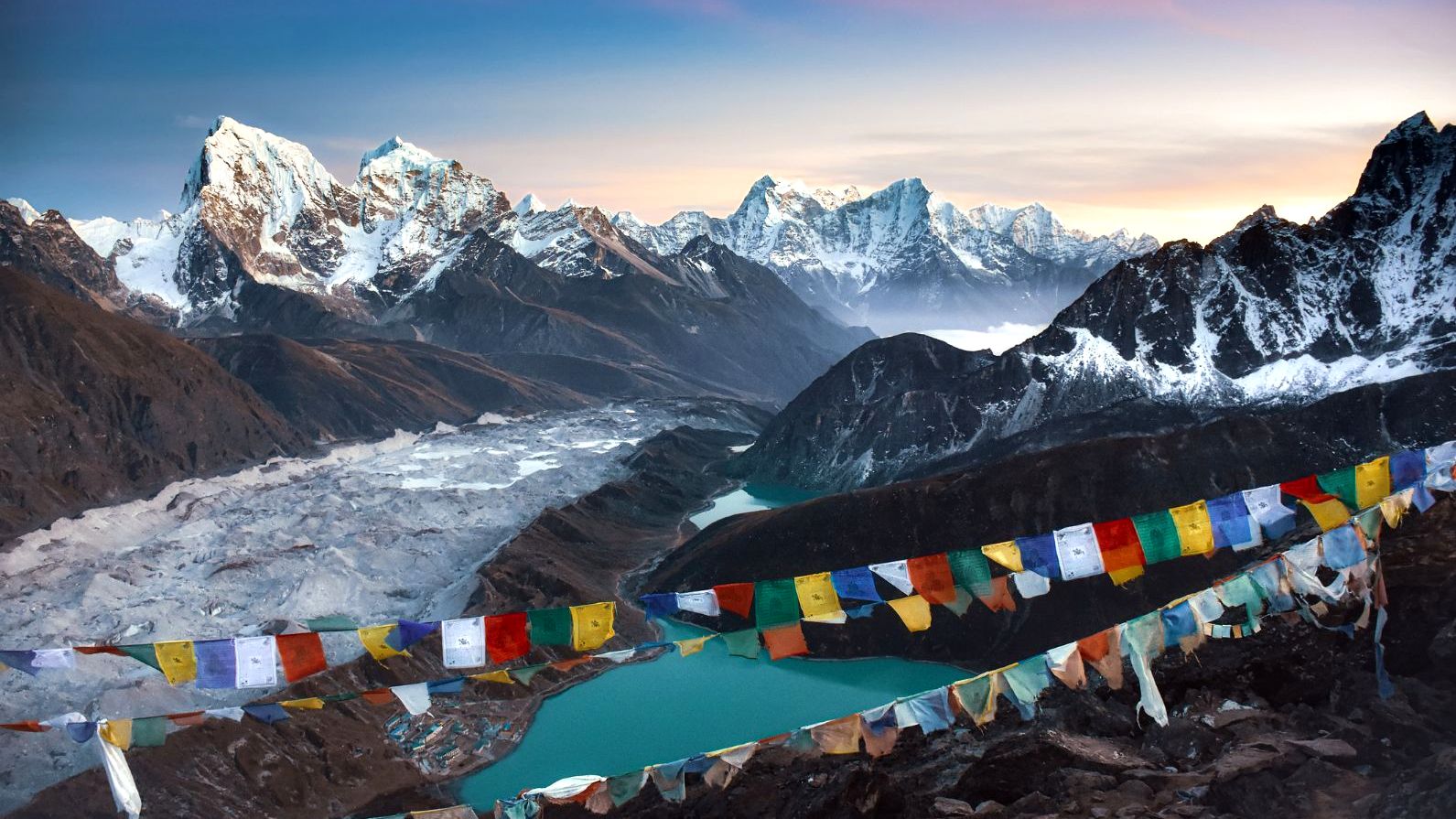
- March marks the end of winter with the temperature starting to warm up. Occasional snowfall can occur at higher altitudes, but the lower trails begin to thaw.
- April sees the weather becoming more pleasant, with warmer days and clear skies. This is the period when the Everest Region really starts to bloom, and the entire trail can be lined with vibrant rhododendron flowers.
- May is when the temperature starts to rise significantly, making high-altitude days more comfortable. This is also when the weather begins to transition towards the pre-monsoon phase, and there can be a slight increase in cloud cover and precipitation.
Summer/Monsoon (June to August)
The monsoon season is marked by heavy rains, which can lead to slippery trails and leeches. The rains also bring landslides and potential trail blockages, making trekking less ideal.
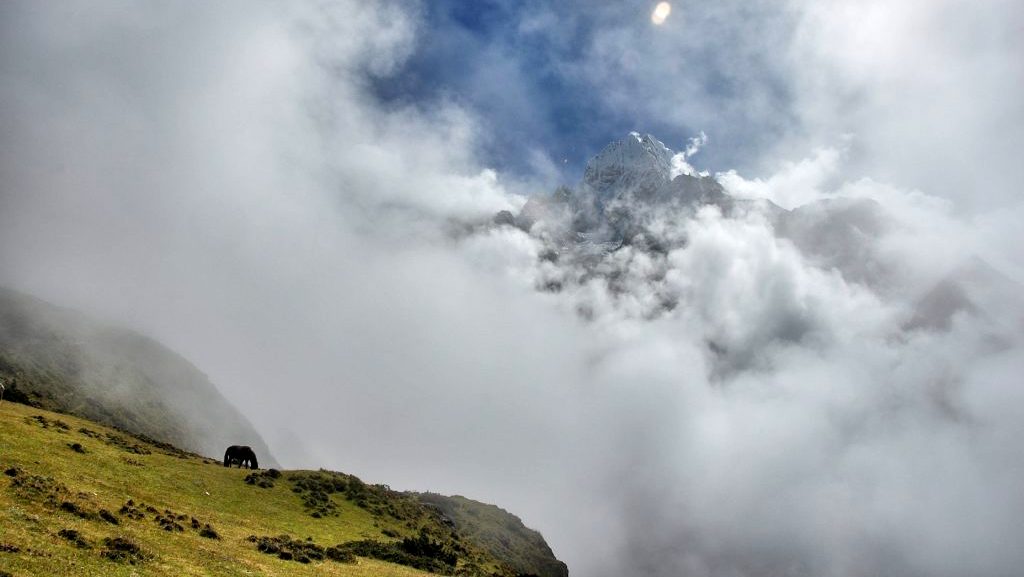
Despite this, the monsoon can offer a unique trekking experience with fewer crowds, greener landscapes, and the challenge that some experienced adventurers might seek.
Autumn (September to November)
After the monsoon has cleared the air, autumn steps in with its crystal-clear skies and stable weather patterns, which are perfect for trekking. This season is favored for its visibility and dry conditions.
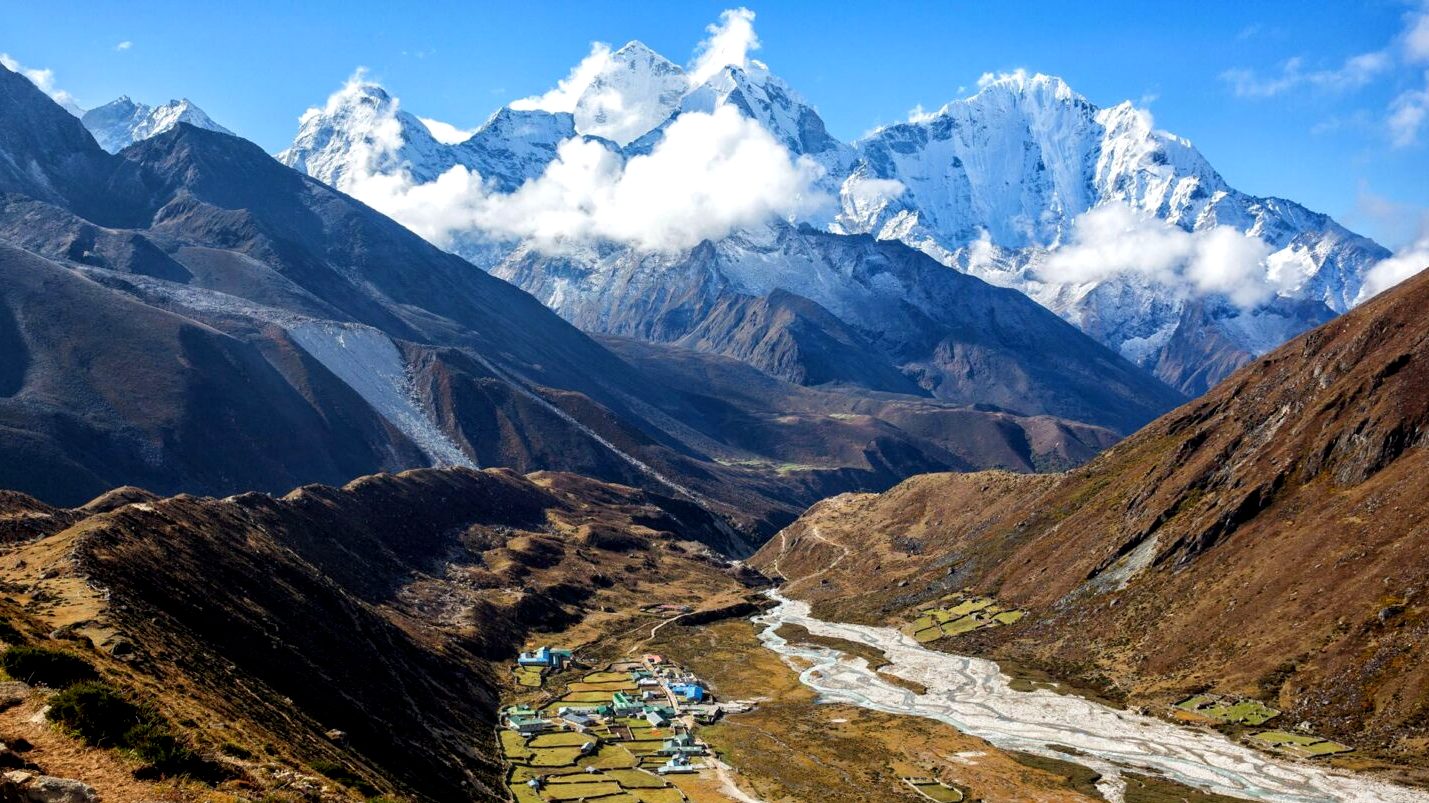
- September still carries the tail-end of the monsoon's humidity, but as the month progresses, rainfall decreases significantly, paving the way for clear views and cooler temperatures.
- October is often considered the most ideal month for trekking in the Everest Region. The weather is predominantly dry with little to no rainfall, and daytime temperatures are comfortably cool for trekking.
- November sees the onset of winter, with cooler days and significantly colder nights. The clarity of the mountain views remains superb, but trekkers need to be well-prepared for the colder temperatures, especially in the evenings and at higher altitudes.
Winter (December to February)
Winter brings cold weather with temperatures often dipping below freezing at higher altitudes. Snow can be expected, particularly above 4,000 meters, which may lead to some high passes being closed.
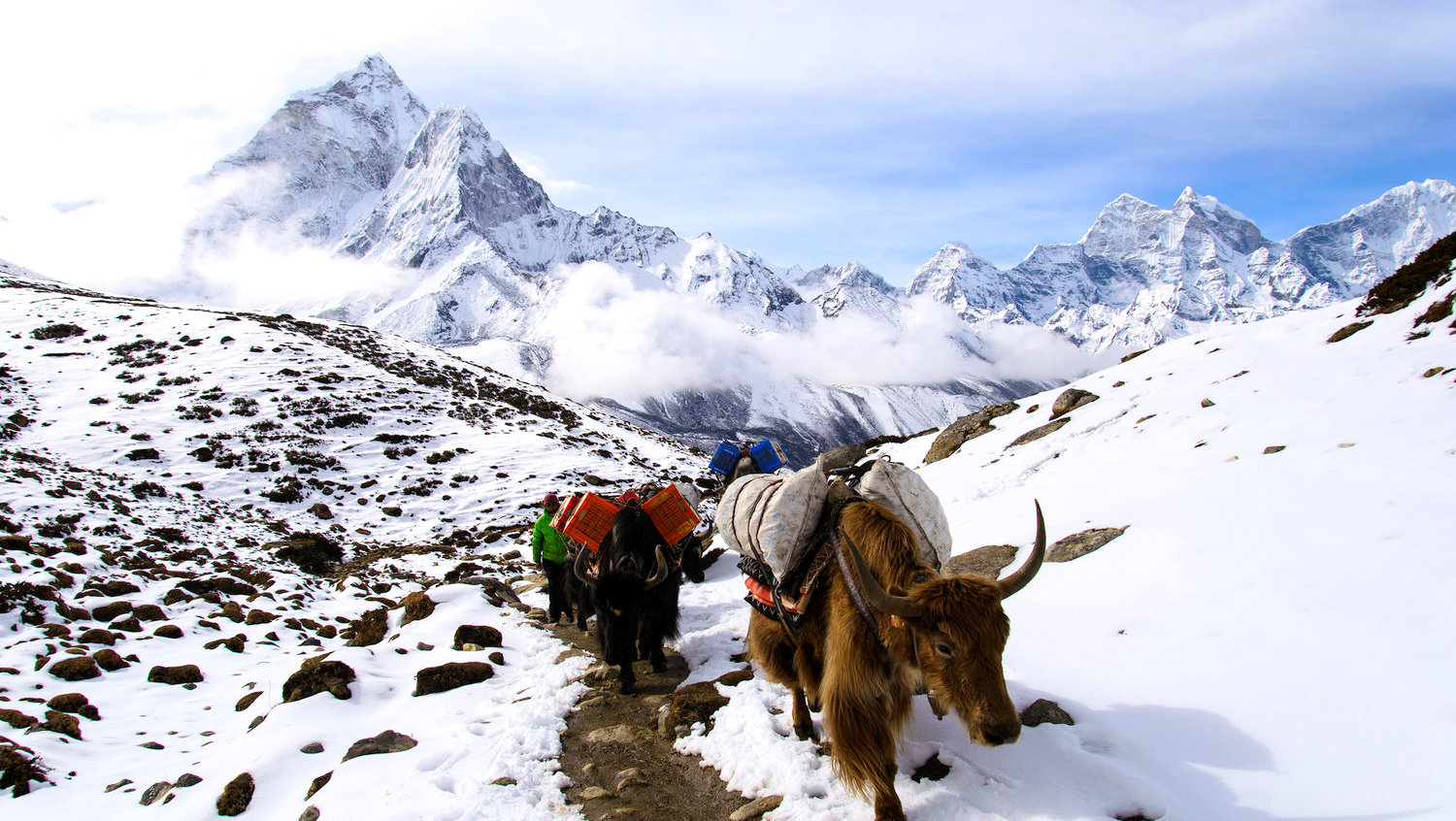
The trails are quieter, and the views are often still very clear, but it is essential for trekkers to be well-equipped for sub-zero temperatures and to be experienced in dealing with potential winter hazards.
Luxury Holidays Nepal emphasizes choosing the right season for your trek to the Everest Region, prioritizing spring or autumn for the best balance of weather conditions, clear skies, and trail quality. Our expert planning ensures that you’re informed, prepared, and ready for an adventure that lives up to your expectations, all while staying safe and comfortable under the watchful eyes of our experienced guides.
Trail Crowding
Trail Crowding is a significant factor to consider when planning a trek to the Everest region. The number of fellow trekkers on the path can affect not only the ambiance of your journey but also the availability of accommodations and other services. Here's what you should know about the trail crowding throughout the year:
Peak Seasons (Spring and Autumn)
Spring (March to May) and Autumn (September to November) are the most popular Everest trekking seasons. During these times, the trails become lively with trekkers from all over the world. Teahouses and lodges are bustling, and the sense of camaraderie among trekkers can add a delightful social aspect to the adventure.
- Advantages: The energetic atmosphere can be invigorating, and for solo trekkers, it's an opportunity to join groups and make new friends. The full operation of teahouses and services ensures a comfortable trek.
- Disadvantages: With popularity comes the challenge of finding solitude. The trails can be busy, and it's often necessary to book accommodations in advance. Some trekkers may find the busyness detracts from their wilderness experience.
Off-Peak Seasons (Winter and Summer)
Winter (December to February) and Summer (June to August), which align with the Everest region's off-season trekking period, see far fewer trekkers.
- Advantages: Those who venture out in these months enjoy a more solitary experience and often have their pick of teahouses. The quiet trails allow for deeper reflection and an intimate connection with nature.
- Disadvantages: Services are limited as some lodges close down, and the trails can be challenging due to snow in winter or mudslides during the monsoon. Trekking in these conditions often requires a more experienced adventurer and additional preparations.
At Luxury Holidays Nepal, we strive to ensure that your trekking experience aligns with your expectations of crowd levels. We offer the flexibility to book your trek during a time that fits your preference for either a sociable journey or a more introspective adventure. Our team expertly navigates the Everest Base Camp trek best season, advising you on the ideal travel windows that align with your desired experience, whether it's during the vibrant high season or the tranquil off-season. With our local expertise and thoughtful planning, we help you find the right balance, so your trek to the Everest region is nothing short of spectacular, no matter when you choose to go.
Visibility
Visibility is a paramount concern for trekkers venturing into the Everest Region, as it greatly influences the overall experience and the grandeur of the Himalayan vistas on offer. The clarity of the skies determines not only the views but also the ability to navigate the trails safely. Here's how visibility factors into the decision on the best months for Everest Base Camp trek:
Spring Season (March to May)
- As spring progresses, the lingering winter haze begins to clear. By April, the air is considerably clearer, offering good visibility. The skies are often a deep blue, providing a stunning backdrop for the magnificent peaks.
- May can occasionally bring cloudier conditions later in the day due to the pre-monsoon warmth, which sometimes results in afternoon clouds building around the mountaintops.
Autumn Season (September to November)
- Post-monsoon, the skies are remarkably clear as the dust and particles have been washed away by the rains. September starts with occasional clouds, but by October, the air is crisp and the mountain views are often at their most spectacular.
- November continues to offer excellent visibility, though temperatures start to drop, and the days get shorter. The clear autumn skies provide some of the most reliable conditions for panoramic views.
Winter Season (December to February)
- Winter boasts clear skies, especially after fresh snowfalls that leave the mountains looking even more dramatic. However, shorter days and the possibility of snowstorms can sometimes hinder visibility and accessibility to higher altitudes.
- This season requires careful planning and constant weather monitoring to make the most of the clear days.
Monsoon Season (June to August)
- During the monsoon, visibility is significantly reduced by the persistent cloud cover and rain. There are occasional clear moments, typically early in the morning, but they are unpredictable.
- Despite the challenges, the moments when the clouds part can be extraordinarily beautiful, as the landscape is lush and the waterfalls are full.
Luxury Holidays Nepal leverages extensive local knowledge to guide trekkers through the Everest Region at times when visibility is typically best, enhancing the trekking experience. We offer expert advice on when to venture out for the clearest skies and provide early morning start options to make the most of the optimal viewing hours. Our guides are skilled at adjusting itineraries on the go to ensure you experience the breathtaking vistas that the Everest Region is known for, all while trekking under the safest conditions. With our guidance, the awe-inspiring sights of the highest peaks on Earth are yours to behold, framed by the most transparent Himalayan skies.
Festivals and Cultural Experiences
In the Everest region, the trekking experience is enriched not just by the magnificent landscapes but also by the cultural festivities and traditions of the local Sherpa people. Timing your trek to coincide with these cultural events can add an unforgettable dimension to your journey.
Festivals in Spring (March to May)
- Losar: Celebrated in February or March, Losar is the Tibetan New Year and a significant festival in the Everest Region, where the Sherpa community, of Tibetan origin, celebrates with colorful decorations, traditional music, and dance performances.
- Dumji Festival: Held in May or June, Dumji celebrates the anniversary of Guru Rinpoche’s birth on the lotus flower. It’s a time of great rejoicing and festivity observed by Sherpa communities with ceremonial dances and gatherings.
Festivals in Autumn (September to November)
- Mani Rimdu: Taking place in October or November, this is one of the most fascinating Sherpa festivals, observed with much fervor at Tengboche Monastery. It consists of a series of sacred ceremonies and culminates in a public celebration with masked dances and theatrical performances.
- Dashain and Tihar: These are two of the most important Hindu festivals celebrated across Nepal, usually falling in late September to October and then in November, respectively. While not as culturally central in the Sherpa community, the wider celebration across Nepal can still be felt in the Everest Region.
Other Cultural Experiences
- Monastery Visits: Trekking during quieter months may also offer more personal and intimate experiences, such as attending the morning or evening pujas (prayers) at the monasteries.
- Sherpa Life: Visiting during non-peak times might also give a closer look at the everyday life of the Sherpas, allowing for personal interactions and understanding of their daily routines and culture.
Choosing the right time for cultural experiences can significantly enhance the trek’s richness, providing memories that extend beyond the trails and into the hearts and homes of the local communities. Whether you wish to immerse yourself in the high-energy festivities of peak seasons or prefer the quieter, more reflective cultural exchanges of the off-season, Luxury Holidays Nepal will craft an itinerary that brings the cultural tapestry of the Everest Region to life for you.
Trekking Conditions
Trekking Conditions are a key consideration for anyone planning to journey through the Everest Region. The conditions underfoot, the state of the trails, and the daily weather patterns can significantly affect your trekking experience. At Luxury Holidays Nepal, we understand the intricacies of these conditions and how they can vary seasonally:
Spring (March to May)
- Trail Conditions: The trails in spring are generally dry and stable, making for good trekking conditions. As the snow from winter melts, it can make higher passes like the Cho La pass a bit tricky but passable with care.
- Daylight: Longer days provide more daylight for trekking, allowing for a relaxed pace and ample time to soak in the views.
- Temperature: Temperatures are moderate, which means you won't be trekking in extreme cold or heat at lower elevations. Mornings and evenings at higher altitudes will still be chilly.
Autumn (September to November)
- Trail Conditions: Post-monsoon, the trails are usually in excellent condition—firm, less muddy, and with less dust. This makes autumn one of the best times for trekking in terms of conditions.
- Daylight: Days are clear and bright, offering some of the best visibility of the year, although the days start to get shorter towards late November.
- Temperature: The weather is cool to warm during the day and cold at night, but it is generally very comfortable for trekking.
Winter (December to February)
- Trail Conditions: Snow and ice can make trails slippery and more challenging, particularly at higher altitudes. Some of the high passes may be closed due to snow.
- Daylight: Days are shorter, which can mean having to start your trek earlier in the day to reach your next stop before dark.
- Temperature: It is cold, especially at night and at higher elevations, with temperatures often dropping well below freezing.
Monsoon (June to August)
- Trail Conditions: The trails can be slippery and muddy, with leeches being common in the lower forests. Streams and rivers swell, and there is a risk of landslides in certain areas.
- Daylight: Cloud cover can make the days seem darker and overcast, with fewer hours of sunshine.
- Temperature: It is warm and humid, which can be draining for some trekkers, and the paths can be uncomfortably wet.
Whether you are a seasoned trekker or a first-time adventurer, understanding and preparing for the varying trekking conditions is crucial for a successful and enjoyable Everest Region trek. Our commitment at Luxury Holidays Nepal is to guide you through these conditions, offering expert advice, and ensuring that your trek, regardless of the season, is a memorable adventure that meets your personal preferences and expectations.
Wildlife and Flora
The Everest Region, also known as the Khumbu region, is as much renowned for its breathtaking landscapes as it is for its rich biodiversity. The trek to Everest Base Camp traverses through the Sagarmatha National Park, a UNESCO World Heritage site, offering trekkers the chance to witness a wide array of wildlife and flora. Understanding the seasonal changes in wildlife activities and plant life can greatly enhance the trekking experience.
Spring (March to May)
- Flora: Spring is when the region comes to life with rhododendrons, magnolias, and a myriad of other wildflowers blooming, particularly at lower elevations. The hillsides and forests become a riot of color, creating a stunning contrast with the white peaks.
- Wildlife: This is also an active period for wildlife. Birds, including the national bird of Nepal, the Danphe (Impeyan Pheasant), are more visible. It's also a good time to spot mammals that are native to this region, like the Himalayan Tahr and the musk deer, as they come down to lower altitudes.
Autumn (September to November)
- Flora: Autumn sees the landscape change color with clear skies and less dust, the pine and fir forests offer a verdant green hue, and the lower forests showcase the changing colors of the season.
- Wildlife: Birds are preparing for migration, and there is often an increase in bird sightings. It's also mating season for some of the high-altitude animals, making them more active and slightly easier to spot.
Winter (December to February)
- Flora: In winter, most of the vegetation is dormant. The higher altitudes are covered in snow, and the lower regions have less foliage, but the stark beauty of the landscape is undeniable.
- Wildlife: Wildlife sightings are rarer as many animals migrate to lower altitudes or hibernate. However, for the keen observer, there are still opportunities to see wildlife tracks in the snow and occasional sightings of hardy high-altitude species.
Monsoon (June to August)
- Flora: The monsoon period sees the region lush and green, with abundant alpine flowers and vegetation. The richness of the flora during this time is unmatched.
- Wildlife: While the rain may make wildlife sightings more challenging, the increased water supply means animals are active. It's a particularly good time for entomologists and those interested in the smaller creatures and insects of the Himalayas.
By trekking with us, you'll gain a deeper appreciation for the Everest Region's natural environment, as we strive to ensure that you experience the area's full biological diversity. We also uphold responsible trekking practices that respect wildlife and plant life, ensuring that we leave minimal impact on the natural habitat.
Acclimatization and Daylight
When planning a trek in the Everest Region, acclimatization and daylight are two crucial factors that can significantly impact your experience. Acclimatizing properly to the high altitude is essential to avoid Acute Mountain Sickness (AMS), and the amount of daylight dictates the length of your daily treks.
Acclimatization
The best time for a trek to the Everest Region is when the weather is mild, and you have the best chances for gradual acclimatization.
-
Spring (March to May) and Autumn (September to November) are considered the best periods for acclimatization due to the stable weather patterns. These seasons provide a gradual increase in altitude as you make your way through the Khumbu Valley, with enough settlements along the way to plan rest days effectively.
-
During the Monsoon (June to August), the increased rainfall can sometimes cause flights to Lukla to be delayed, which may affect your acclimatization schedule. Moreover, trails can be less crowded, which might be a positive for some trekkers but also means fewer services and potential support if needed.
-
Winter (December to February) can be quite challenging for acclimatization due to the extreme cold and shorter days. The lower oxygen levels at cold temperatures can increase the difficulty of acclimatizing.
We provide itineraries that are designed with proper acclimatization days included. Our experience ensures that trekkers have adequate time to adjust to the altitude, with knowledgeable guides who monitor your well-being throughout the trek.
Daylight
The amount of daylight you have affects not just your trekking hours but also the scenery you can enjoy.
-
In Spring, the days are longer, which allows for more leisurely-paced treks and the opportunity to enjoy the breathtaking landscapes during the daylight hours. You can start your treks early and still have daylight left in the evenings to relax and enjoy your surroundings.
-
Autumn also offers good daylight hours, and the clear skies after the monsoon rains provide some of the best visibility for mountain views.
-
Winter has shorter days, which means you need to start your daily trek early to make sure you reach your next destination before dark. While the trails are less crowded, the shorter days require good time management.
-
The Monsoon season has enough daylight, but visibility can be poor due to the rain and cloud cover. Treks may also start late if mornings are foggy or wet, which can shorten your trekking day.
With Luxury Holidays Nepal, you don't have to worry about the logistical aspects of your trek. Our expert team organizes treks with daylight in mind, scheduling walks to take full advantage of the available sunlight while ensuring you're safely at your next stop before dusk. Our detailed itineraries are designed to maximize your experience and safety, whether you're trekking during the long days of spring or the shorter, crisp days of autumn.
Everest Base Camp Weather by Month
Trekking to Everest Base Camp is an unforgettable adventure, and the weather can significantly impact your experience. Here's a month-by-month breakdown of the Everest Base Camp weather to help you plan when to trek:
January
- Weather: Cold and snowy, with clear skies.
- Daytime Temperatures: Can range from 5°C to -6°C at Base Camp.
- Nighttime Temperatures: Can drop to -20°C or lower at Base Camp.
February
- Weather: Still cold, but less snowfall and longer daylight hours.
- Daytime Temperatures: Around -1°C to 4°C at Base Camp.
- Nighttime Temperatures: As low as -15°C at Base Camp.
March
- Weather: Beginning of the spring season; weather starts to warm up with occasional snowfall.
- Daytime Temperatures: Around 2°C to -5°C at Base Camp.
- Nighttime Temperatures: Around -12°C at Base Camp.
April
- Weather: One of the best times to trek; warmer and stable weather with clear skies.
- Daytime Temperatures: From 5°C to -5°C at Base Camp.
- Nighttime Temperatures: Around -10°C at Base Camp.
May
- Weather: Last month of the spring climbing season; slightly warmer.
- Daytime Temperatures: From 10°C to 0°C at Base Camp.
- Nighttime Temperatures: From -5°C to -15°C at Base Camp.
June
- Weather: Start of the monsoon; wet and clouds can obscure views.
- Daytime Temperatures: Around 16°C at lower altitudes, 5°C at Base Camp.
- Nighttime Temperatures: Slightly above 0°C at Base Camp.
July
- Weather: Peak of the monsoon; wettest month with potential for leeches on lower trails.
- Daytime Temperatures: Around 15°C at lower altitudes, 2°C to 5°C at Base Camp.
- Nighttime Temperatures: Slightly above 0°C at Base Camp.
August
- Weather: Continuation of monsoon conditions; unpredictable with occasional breaks in rain.
- Daytime Temperatures: From 15°C at lower altitudes to 5°C at Base Camp.
- Nighttime Temperatures: Slightly above 0°C at Base Camp.
September
- Weather: End of monsoon; weather starts improving with chances of clear days increasing.
- Daytime Temperatures: From 15°C at lower altitudes to 2°C at Base Camp.
- Nighttime Temperatures: From -2°C to -10°C at Base Camp.
October
- Weather: One of the most popular trekking months; clear skies and stable weather.
- Daytime Temperatures: From 12°C at lower altitudes to -6°C at Base Camp.
- Nighttime Temperatures: From -5°C to -15°C at Base Camp.
November
- Weather: Cold starts setting in, but clear views and stable weather continue.
- Daytime Temperatures: From 6°C at lower altitudes to -5°C at Base Camp.
- Nighttime Temperatures: From -10°C to -20°C at Base Camp.
December
- Weather: Winter begins; very cold with shorter days, but still possible to trek.
- Daytime Temperatures: From 4°C at lower altitudes to -8°C at Base Camp.
- Nighttime Temperatures: From -15°C to below -20°C at Base Camp.
At Luxury Holidays Nepal, we provide comprehensive advice on what to expect weather-wise during your trek. Our itineraries are designed to maximize your comfort and safety, regardless of when you choose to embark on this incredible journey. We are committed to offering a sublime trekking experience by equipping you with quality gear, expert guidance, and updates on weather conditions to ensure you're prepared for the trek, no matter the month.
As the journey through the majestic trails of the Everest Region draws to a close, it becomes clear that the optimal time for embarking on this adventure falls in the embrace of spring (March to May) and autumn (September to November). These seasons promise the most favorable conditions—crisp visibility, stable weather, and vibrant cultural tapestries—for trekkers seeking the unparalleled experience that Luxury Holidays Nepal offers. Whether you are a seasoned mountaineer or a passionate novice, planning your trek during these months ensures a blend of safety, beauty, and an enriched connection with the Himalayas, making every step an unforgettable part of your trekking legacy.
FAQs: Best Season for Trekking in the Everest Region
Q: What is the best time to trek to Everest Base Camp?
A: The best time to trek to Everest Base Camp is during the spring (March to May) and autumn (September to November) when the weather is stable and the visibility is clear, offering breathtaking views of the Everest region.
Q: Can you trek to Everest Base Camp in winter?
A: Yes, trekking to Everest Base Camp in winter (December to February) is possible but it's cold and challenging, with the chance of heavy snowfall. Proper gear and preparation are essential for a safe and comfortable trek.
Q: Is the monsoon season suitable for trekking in the Everest Region?
A: Monsoon season (June to August) is less ideal for trekking due to heavy rainfall, potential landslides, and leeches. However, the trails are less crowded and the landscape is lush.
Q: What are the Everest Base Camp trekking conditions like during high season?
A: During the high season for Everest trekking, the trails are well-maintained, and conditions are generally dry and stable, making for a pleasant trekking experience.
Q: When is the Everest Region the most crowded?
A: The Everest Region sees the highest number of trekkers during the spring and autumn months, especially in April, May, October, and November.
Q: Are there any off-season benefits to trekking in the Everest Region?
A: Off-season trekking in the Everest Region, particularly in winter and during the monsoon, offers the benefits of fewer crowds, discounted rates on accommodation and services, and a unique perspective of the landscape.
Q: What should I know about acclimatization if I trek in the Everest Region?
A: Proper acclimatization is crucial to avoid altitude sickness. Planning your itinerary with adequate acclimatization days, especially at higher altitudes, is key to a successful Everest trek.
Q: How does the weather vary from month to month in the Everest Region?
A: The Everest Base Camp weather by month can range from warm and sunny days during spring and autumn to cold and snowy conditions in winter, with the monsoon season bringing rain and cloud cover.
Q: What is the Everest trekking weather like in spring vs autumn?
A: The spring weather tends to be slightly warmer with blooming flowers, while autumn provides clearer skies and more stable weather, though temperatures start to drop as winter approaches.
Q: What type of wildlife and flora can I see during the best trekking seasons?
A: During the spring and autumn, trekkers can see a variety of flora including rhododendrons and wildflowers, as well as wildlife such as Himalayan Tahrs, Musk Deer, and different bird species.
Q: How does Luxury Holidays Nepal ensure safety during the trek?
A: Luxury Holidays Nepal ensures safety by providing experienced guides, regular weather updates, proper acclimatization schedules, and contingency plans for emergencies.
If you need any further information, please contact us by email: at [email protected], Phone: at +977- 985 100 5129 (WhatsApp)




